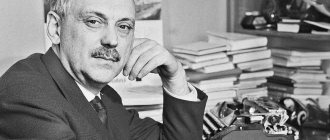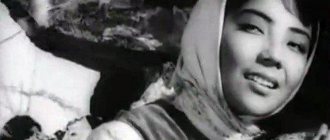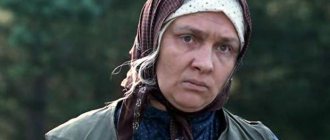Biography
Mikhalkov Sergei Vladimirovich did not experience a shortage of female attention, and therefore was known as a ladies' man. But one day, when I came to visit the artist Konchalovsky and saw his daughter Natasha, I lost my head. It was love at first sight and until the end of life.
On January 6, 1903 (and according to the old style, January 19) in the city of St. Petersburg, Natalya Petrovna Konchalovskaya was born into a family of famous artists. Painting was in the Konchalovskys’ blood: Natalia’s father, brother, paternal grandfather, and even Natalya’s maternal grandfather, the famous Vasily Surikov, were artists. Natasha was raised by Olga Vasilievna, whom her daughter remembered as a courageous, strong and cheerful woman.
Portrait of Natalia Konchalovskaya
Before the 1917 revolution, Natasha traveled a lot with her family. While traveling, the girl studied foreign languages, which later helped the future writer in translating literary works of world authors into Russian. At the same time, the artistic taste of the future writer was formed - Natasha met works of art by world masters while traveling.
Natalya Konchalovskaya in childhood
The biography of the Konchalovsky family surprises with the abundance of famous names among relatives and friends. During the period of revolutionary changes in the life of Russia, the Konchalovskys lived in their father’s workshop, near Triumphal Square, in Moscow, and Mikhail Afanasyevich Bulgakov was their next-door neighbor. The period of the revolution turned out to be difficult - receiving food cards, living half-starved, there was often no heating and electricity.
But despite the difficulties of everyday life, spectators filled the theaters. Frequent guests in the Konchalovskys' house were Prokofiev, Tolstoy, Ehrenburg, Eisenstein and others. The atmosphere of the Konchalovskys’ house simply left no choice for the growing Natasha. Since childhood, the girl wrote poetry and adored classical music.
Little Natalya Konchalovskaya and her grandfather Vasily Surikov
In 1910, Natasha entered the Pototskaya gymnasium to study. In the building where the gymnasium is located, the composer Sergei Vasilyevich Rachmaninov lived and worked, whose music the girl listened to between classes. His passion for music continued when he met the Chaliapin family. Natalya’s son, Fyodor Ivanovich, an actor who immigrated to Europe, later became Natalya’s good friend; the girl even visited the Chaliapins in Italy.
Natalya Konchalovskaya in her youth
Natalya’s godfather was the sculptor Sergei Timofeevich Konenkov, whose girl often stayed in his workshop, watching the master’s work. There she listened to Yesenin’s poetry and met Isadora Duncan. From childhood, Konchalovskaya recalled that despite her diversified development and many talents, she was not prepared for any specialty, but at the same time, the girl perfectly mastered housekeeping under the guidance of her wise mother Olga Vasilievna.
“I grew deeply into the life of a family for which spiritual culture, art, and constant work were the basis of existence,” recalled Natalya Konchalovskaya.
Mikhalkovs and Konchalovskys. Nest of the Elite (N. B. Goreslavskaya, 2008)
House in Bugry
The atmosphere in the house of Pyotr Petrovich, who lived most of his life in a former manorial estate called Bugry, located in the Kaluga region, 110 kilometers from Moscow, made an indelible impression on his grandchildren Andron and Nikita. After all, they spent the whole summer there almost until their grandfather’s death. Memories of this time come through every now and then in their statements, articles, interviews, and A.S. Konchalovsky even dedicated an entire chapter in his book “Low Truths” to his famous artist grandfather and a description of life in his house. I would like to quote a few excerpts from there - after all, it was my grandfather’s house that largely influenced the formation of his and his brother’s personalities and their worldview. Although it cannot be said that their worldview is always similar in everything. But let’s turn to A. Konchalovsky’s memories of his grandfather’s house.
“My grandfather, Pyotr Petrovich Konchalovsky, was a deeply Russian man, but he could not live without Europe. Everything in his house breathed with Europe, not to mention the fact that in painting he was a Cézannest. The first time he traveled to Spain was somewhere at the very beginning of the century with his father-in-law Vasily Ivanovich Surikov. They painted sketches all over Europe.
Grandfather spoke excellent French - Surikov’s wife was half-French, so for grandmother French was the first language.
I often think: why was our family not affected by repression? After all, they could have hurt us already in the pre-war years. They weren’t seriously imprisoned in the military; mass imprisonments began again in 1947 with the start of the campaign against cosmopolitans. It was easy for Pyotr Petrovich to fall into this category; he was thoroughly pro-French. Although he was an academician, he refused to paint Stalin’s portrait, by the way.
This happened in 1937. For the anniversary of the revolution, all academicians had to paint portraits of the leader. They also offered it to Pyotr Petrovich. He didn’t know how to get out of it, he said that he would paint a portrait, but only if Joseph Vissarionovich would pose for him every day.
– Do you understand? Comrade Stalin has no time. Follow the photo.
- I can not. I'm realist. I don’t paint portraits from photographs.
This grandfather was not forgotten - until 1956 he did not have a single personal exhibition.” (However, we note in parentheses that in 1943 P.P. Konchalovsky was awarded the Stalin Prize. So, apparently, his disgrace was not so severe. It is also possible that the situation with exhibitions was influenced not so much by power as by the difficult relations between artists himself, especially the academic elite to Konchalovsky and his comrades. But the grandson thinks differently. It seems to him that the “sword of Damocles” of repression has always hung over his grandfather’s family. But why didn’t it fall?)
“I think what saved our family was that in his speech at the beginning of the war, Stalin named two artists, Repin and Surikov, among the great names that the Russian nation gave to the world. This speech was revered as historical; it included us in the category of untouchables. That’s why my grandmother, Olga Vasilievna, who was often quite unrestrained, could easily say things that would never have been forgiven to others. When the Minister of Culture spoke, she snorted: “God, what is he talking about!” She treated Soviet power quite unequivocally. The lifestyle that he and his grandfather led made this clear...
In his house I always felt like I was in a special pre-revolutionary Europeanized world; the adults always spoke French in front of their grandchildren, and it was full of Spaniards.
The Spanish colony was generally an important part of our life. At the end of the 30s, when Franco defeated the Republicans, several thousand children of Spanish communists, accompanied by Spanish Komsomol members, came to the USSR. Their colony was located a few kilometers from our grandfather’s house near Obninsk. The Spaniards began to visit him often - in his house you could sing, speak Spanish, there was a European atmosphere here. About twenty of them came at once...
During the revolution, the Konchalovsky family lived in the workshop of Pyotr Petrovich on the Garden Ring near Triumphal Square, in the very entrance where Bulgakov lived. The workshop, by the way, has been preserved and still belongs to the Konchalovskys.
Khlebnikov and Burliuk were here. Mayakovsky came here in his yellow blouse, with a carrot sticking out of his pocket instead of a scarf. My grandfather was from the “Jack of Diamonds”; by that time, the Bubnovov pilots had quarreled with the futurists. “Futurists have nothing to do here,” said the grandfather and slammed the door in Mayakovsky’s face. Paintings were painted here. The family lived here. It was cold. The potbelly stove was burning. Mom cooked on it...
Mom was from this world - artists, rebels. (Which, we note once again, did not stop her from writing her most famous patriotic and highly ideological poem, “Our Ancient Capital,” and also for a long time trying to persuade her eldest son not to leave for the West. “You cannot live without your Motherland,” she repeated to him in letters. That is, Natalya Petrovna, who came from the world of rebel artists, was a patriot of her country, which was then called the USSR. No matter how much her son would like to think differently now).
Everyone who visited the house knew her since childhood, for everyone she was Natasha. Pototskaya's gymnasium, where she studied since 1910, was located on Pushkin Square, behind the Rossiya cinema, where the Press Committee is now. And Rachmaninov lived on the top floor of the house. During breaks between lessons, the girls gathered on the stairs and listened to the roar of the piano. Sometimes the door opened, a tall, thin, slightly hunched gentleman in a hat and coat came out; they knew it was Rachmaninov. When leaving, he always said: “Bonjour, mademoiselle.” The girls watched as the amazing musician walked down the stairs.
Then, while living in America, my mother saw him at concerts. His fame was booming. Mom loved Rachmaninov very much, even more than Scriabin. She had many records with his recordings... The Konchalovskys were familiar with the Chaliapins, they visited them in Capri. Gorky lived there at the same time. Mom was very friendly with Chaliapin’s son Fedya, Fyodor Fedorovich. Then I was friends with him, he starred in my “Inner Circle”...
...Life in the Konchalovsky family was working. My grandfather worked from morning to evening - if he wasn’t painting, he was making stretcher frames, stretching the canvases himself, nailing them with small wallpaper nails, and priming them himself. He was a passionate hunter. He had a pointer, a real hunting dog, and more than one. There were greyhounds...
In addition to painting and hunting, my grandfather had two passions - juniper sticks and garden knives. I made a whole collection of both of them. The sticks were made from juniper, the handles were cut from roots. How wonderful they smelled! The handles for the knives were made of crooked cherry wood, the blades were made of braids, sharpened sharply, and finished with copper - the knives were very beautiful.
Everyone dressed very simply, in the manner of American farmers. Overalls were made from cheap blue linen (denim was unknown in our country at that time) - for grandfather, for uncle. For an artist, such clothes are very convenient: pockets for tools, easy to wash, easy to remove. American soldiers' boots made of leatherette were put on their feet; in the first post-war years they were sent under Lend-Lease.
I remember a terrible scandal that unfolded before my eyes around 1948. Mom arrived at the dacha in nylon stockings, and grandmother was terribly outraged:
– What right do you have to wear nylon stockings?! Where have you come?! This is debauchery! We live modestly! We are working people here.
Grandmother herself wore opaque thread stockings...
(It is surprising, of course, to read about this scandal after the story about greyhounds.)
There was no running water in the house; in each room, on a stool, there was a faience basin with patterns and a faience jug for water. When washing, either someone helped by draining the water from the jug, or water was simply poured into the basin and scooped up with the palms of the hands. My grandmother had a washbasin, an ordinary country one, with a metal rod through which water flowed in a trickle - that’s all the achievements of civilization.
There was a copper barometer, they knocked on it - what will the weather be like? The wall clock chimed and the kerosene lamps burned. It didn’t cost my grandfather anything to install electricity – there was a railway line one and a half kilometers away. But he didn’t want electricity, didn’t want to hear the radio, didn’t want to know what was going on around him. He preferred to remain in a different era, did not want to live in the twentieth century, although as an artist, of course, he lived in the twentieth: “Jack of Diamonds” was one of the most revolutionary artistic groups.
My grandfather lived like a Russian small-scale nobleman of the late 19th century: he raised pigs, dug up lilacs and apples, and took honey. We had a horse, Zvezdochka, I knew how to harness it. There was a cart. There were two cows and rams. The way of life was harsh, but good and solid. The stove was burning in the servants' room, and Masha, our nanny, was in charge. On Peter's Day, peasants came and brought grandfather a goose as a gift. In response, vodka was displayed, and conversations began about the old, pre-revolutionary life, when Troyanovsky owned the estate. The chairman of the collective farm usually came with the men; he was also from the locals.
...And “Sibiriyada”, and “The Noble Nest”, and “Uncle Vanya” are full of childhood memories. When you wake up in the morning, you smell of honey, coffee and the buns your mother baked. The smell of a mother. The smell of grandfather - he had breakfast early, drank coffee, with coffee there were butter rolls, butter and Roquefort, good Roquefort, from those Stalinist times. The smell of childhood...
At night, my grandfather and I went to the toilet, I was afraid to go alone: nettles, the sun was setting, the pine trees were rustling...
The entire plywood paneling of the toilet was covered with autographs - what autographs! Medtner, Prokofiev, Pasternak, Sergei Gorodetsky, Okhlopkov, Count Alexey Alekseevich Ignatiev, Meyerhold...
The collection of autographs on the plywood of the toilet has been growing since the late 20s. There were also drawings, very elegant, without a hint of obscenity, characteristic of this type of wall art. There were inscriptions in French. Medtner wrote: “Here the wonders of the kitchen fall into ruin.” If I had understood in those years what the true price of this plywood was, I would have cut it out of the wall and would never have given it to anyone!
...Grandfather really appreciated Prokofiev. It's funny, but people in the house treated Shostakovich with restraint. It would seem that now the opposite is true: Shostakovich is placed on a pedestal, Prokofiev is considered an opportunist. It seems to me that Prokofiev is underestimated by world music criticism.
When my grandfather painted a portrait of Prokofiev, he would compose “Fleetingness,” go to the piano, and play the pieces. Once, while playing music like this, my grandfather said:
– Sergey Sergeevich, here we need to stay longer, we need to extend it further...
– That’s the trick. Just because you want to stay here longer, I’m changing the key.
My older sister, from my mother’s first marriage, Katenka, was still very young at that time. One day, when grandfather and Prokofiev went out to dinner, she went up to the portrait and began to dirty it - downstairs, where she could reach. Grandfather returned, saw the dirt, waved his hand and drew pine cones on the ground where it had become dirty. This portrait of Prokofiev is very famous, especially since there are very few picturesque portraits of him...
The activities of grandchildren and children in the house were not taken seriously. Only my grandfather’s occupation was considered serious. We were forbidden to draw. In the same way, Mom and Uncle Misha were forbidden to draw when they were little. Children often copy adults; children of artists become artists simply by imitation, having neither talent nor calling. Uncle Misha was allowed to draw only after a suitcase of drawings was found under his bed. They said: “If you wrote without being afraid of punishment, maybe you have a calling.” He did not become a great artist, but he wrote, drew and was happy.
Grandfather considered his grandmother, Olga Vasilievna, to be his main and only judge in everything related to painting. If she said, “Redo it here,” he would redo it. He never released a single canvas without her approval. If she said “no,” he could calmly take a knife and cut the canvas and throw it away. More often in such cases he simply pulled it over to the other side. Grandmother’s verdict was final...
My grandfather had an interesting character. He never entered into conflict with anyone, he spoke ironically about everything, first of all, about Soviet power. Of course, it was a sore point that he didn’t have a single personal exhibition, while Alexander Gerasimov had one almost every six months...
...Only later did I understand what a rare happiness it was to live in this environment, what a luxury in those Stalinist years it was to sit in a Russian artist’s house, where in the evenings candles were lit and kerosene lamps were carried from room to room, where Roquefort and coffee were served on the table with cream, red wine, some strange, inspired conversations are taking place. It would be strange, living in this world, not to absorb from it something important for the future life, for the profession ... "
Literature
Natalya Petrovna Konchalovskaya's literary activity began with translations of works by Browning, Stelmakh, Rubinstein and others. Here Natalya’s knowledge of languages since childhood came in handy. Konchalovskaya’s most famous work in this area was the translation of the poem “Mireille”. Then books about the life of the French woman Edith Piaf were published.
Illustrations for poems by Natalia Konchalovskaya
But Natalya Konchalovskaya became famous as a children's writer and poet. The book “Our Ancient Capital,” where the author described the history of the Russian people and state in a language understandable to children, brought Natalya Petrovna recognition from her contemporaries.
In a narrow monastery cell, within four blank walls, a monk wrote down stories about the land and ancient Russian stories.
This is how Natalya Petrovna told the children about the sources of knowledge about Moscow and Russia. In addition, in her works the writer taught children to see beauty in the everyday. Thus, in the story “Not Made by Hands,” included in the book “Magic and Hard Work,” the author unobtrusively introduces the reader to the work of the Russian artist Vrubel, seeing the outlines of his canvas in relief in the snow.
Natalia Konchalovskaya's book “Our Ancient Capital”
Konchalovskaya devoted a lot of time and effort to popularizing the work of her grandfather, the artist Vasily Ivanovich Surikov, and dedicated one of her books, “The Priceless Gift,” to him. Natalya’s virtuoso piano playing helped the writer create the “Note ABC” for children learning a musical instrument.
Seeing the beauty in the ordinary
View gallery
Another task that Natalya Petrovna set for herself was the desire to teach children to see the beautiful and amazing in the most everyday things. For example, in the collection “Magic and Hard Work” there is a story “Not Made by Hands,” in which Konchalovskaya introduces the reader to Vrubel’s most famous works, seeing the outlines of his canvases on ordinary snow.
Studying the biography of Natalya Konchalovskaya, we can say that she paid special attention to popularizing the work of her grandfather, the great artist Vasily Ivanovich Surikov. She dedicated her book to him entitled “The Priceless Gift.”
In addition, throughout her life, the heroine of our article honed her skills in playing musical instruments. She played the piano beautifully and even wrote an original manual for children called “The ABC of Music,” which helped them master this difficult instrument.
Also among her famous books are “The Memory Pantry”, “Troubadours and Saints of Mary”, “Magnetic Attraction”.
Personal life
From her youth, Natalya Petrovna was surrounded by the attention of talented young people and was a welcome guest at parties. At one of these evenings, young people vying with each other boasted about their plans for the future, and Natasha announced her intention to get married and have five children. This phrase played an important role in the life of young Konchalovskaya. The girl was noticed by the promising and successful dandy Alexei Alekseevich Bogdanov, the son of a merchant who sold tea.
Natalya Konchalovskaya with her first husband Alexei Bogdanov
Alexey Bogdanov himself was engaged in trade with the United States, and everything in his life worked out: wealth, wife, but there were no children in the family. It was then that the forty-year-old handsome man met Natalya, with whom he later left for America. Having already become legal spouses by that time, the newlyweds settled in Seattle. One day, while cleaning her husband’s table, Natalya, already pregnant with her first child, found a letter from her ex-wife, where she cursed the Bogdanov family and their children.
Natalya Konchalovskaya and second husband Sergei Mikhalkov
That same night, the believer Konchalovskaya suffered a miscarriage. Spontaneous abortions occurred six more times in the young woman’s life. And only in November 1931, upon returning to Russia, Natalya’s daughter Ekaterina was born. At the country estate where the family settled, there were also often talented guests, the creative elite of Moscow - Natalya tried to introduce her husband to the world of art. Realizing the futility of her efforts, Natalya Petrovna asked for a divorce. In 1937, Alexei Bogdanov committed suicide after being arrested.
Natalya Konchalovskaya with her sons Nikita and Andrey
In 1936, Natalya Konchalovskaya remarried, to the then little-known poet Sergei Mikhalkov, who, moreover, was 10 years younger than his wife. Despite Sergei Vladimirovich’s occasional affairs on the side, the couple lived a long and happy life together, celebrating 50 years of marriage. In her second marriage, the writer gave birth to two more children - Nikita Mikhalkov and Andrei Konchalovsky. Ekaterina Konchalovskaya was adopted by her stepfather and raised as his own daughter. In their marriage, Sergei Vladimirovich and Natalya Petrovna had 7 grandchildren and 6 great-grandchildren, who became heirs not only of the famous surname, but also of the family’s talents.
Children
The daughter of Natalya Konchalovskaya, whose photo is in this article, married the famous Soviet writer Yulian Semenov, the founder of the newspaper “Top Secret” and the magazine “Detective and Politics”. In Soviet periodicals, he was one of the founders and popularizers of the genre of investigative journalism. Since 1960 he worked as a writer.
He is the author of the famous novel “Seventeen Moments of Spring”, based on which Tatyana Lioznova filmed the series of the same name; he dedicated an entire series to Stirlitz and Isaev. There are also series of works about state security colonel Vitaly Slavin, police colonel Vladislav Kostenko, and journalist Dmitry Stepanov. Semyonov often reworked his novels into scripts. Among the famous film adaptations are “Major “Whirlwind”, “Confrontation”, “TASS is authorized to declare...”, “Petrovka, 38”.
In 1967, the couple had a daughter, Olga. Now she is the head of the Yulian Semenov Cultural Foundation, which helps Orthodox orphanages.
In 1937, Natalya Konchalovskaya and Sergei Mikhalkov had a son, Andrei, who took his mother’s surname when he grew up. Andrei Konchalovsky became a famous director. Among his famous works are “The Story of Asya Klyachina, who loved but did not marry”, “The Noble Nest”, “Siberiada”, “Tango and Cash”, “Ryaba Hen”, “House of Fools”, “White Nights of Postman Alexei Tryapitsyn” ", "Paradise". After perestroika, he worked in the USA for some time. There he shot several of his films.
The second son of the heroine of our article became an even more famous film director - Nikita Mikhalkov. He was born in 1945. Subsequently he became the winner of prestigious film awards. He won the Oscar for Best Foreign Language Film and the Grand Prix at the Cannes Film Festival for the drama Burnt by the Sun. Winner of the Golden Lion at the Venice Film Festival for the film Urga - Territory of Love. He was nominated for an Oscar two more times.
Death
Natalya Petrovna spent her last years in a country house in the Odintsovo district of the Moscow region. According to the memoirs of Nikita’s son, Konchalovskaya passed away easily and calmly. Natalya Petrovna lived a long (85 years), happy and fruitful life, leaving to her descendants many books and poems on which several generations of Russian children were raised.
Natalia Konchalovskaya's grave
The funeral service was conducted by Patriarch Pimen in the Trinity Cathedral, and the children's writer was buried at the Novodevichy Cemetery. Photos of Natalya Petrovna from the beginning of the 20th century, preserved in the Mikhalkov family archive, show all the strength, love of life and energy of this fragile woman, which she channeled into creativity.
Bibliography
- 1989 – “Magic and Hard Work”
- 1988 – “Edith Piaf. A song gathered into a fist"
- 1987 – “Favorites” in 2 volumes
- 1981 – “In Search of Vishnevsky”
- 1980 – “Memory Pantry”
- 1979 – “Magnetic Attraction”
- 1973 – “Memory Pantry”
- 1972 – “Troubadours and Saints of Mary”
- 1965 – “Song gathered into a fist”
- 1964 – “The Priceless Gift”
- 1961 – “Son of the Siberian Land”
- 1959 – “Zhongguo, nin hao!”
- 1953 – “Our Ancient Capital”
- 1940-1970 – Poems










